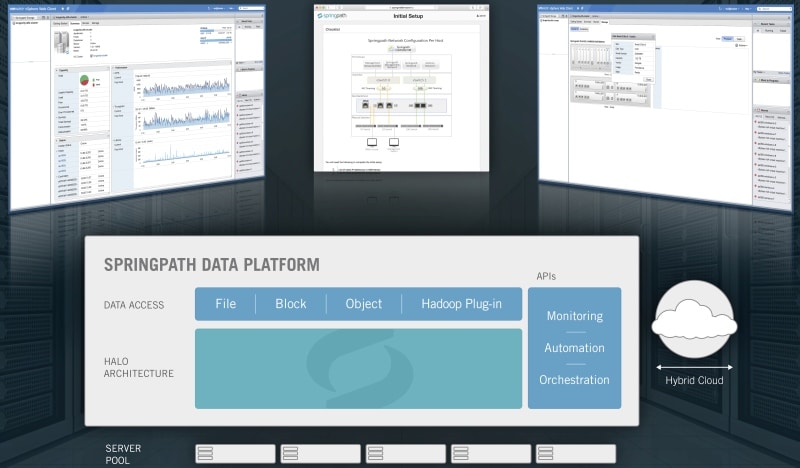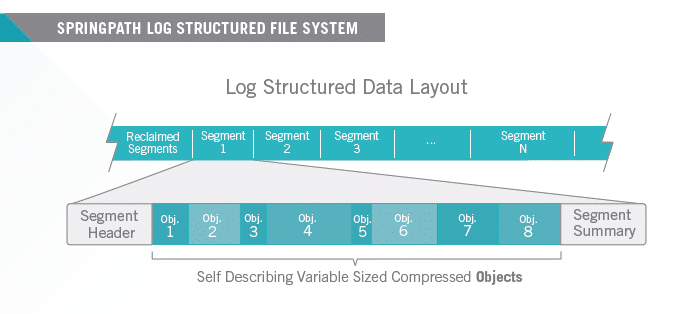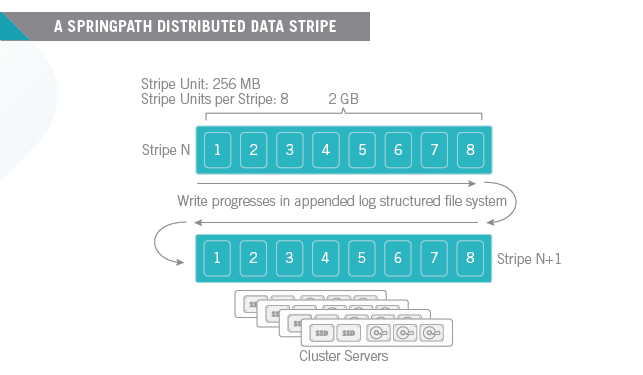Springpath today announced its public launch, including details about the Springpath Data Platform, the company's signature software-based data platform. Built on the company’s proprietary Hardware Agnostic Log-structure Objects (HALO) architecture, this platform incorporates storage, management, and data protection functionality. The Springpath Data Platform is supported for use with servers from Cisco, Dell, HP, and Supermicro and offers file, block, and object storage.
Springpath today announced its public launch, including details about the Springpath Data Platform, the company's signature software-based data platform. Built on the company’s proprietary Hardware Agnostic Log-structure Objects (HALO) architecture, this platform incorporates storage, management, and data protection functionality. The Springpath Data Platform is supported for use with servers from Cisco, Dell, HP, and Supermicro and offers file, block, and object storage.
The Springpath Data Platform implements highly available clusters for groups of three or more servers which have been configured with the Springpath Controller software. The controller software communicates across nodes via Ethernet and allows each server to offer its compute and data services to the network. Springpath’s proprietary HALO architecture uses a distributed filesystem with built-in support for snapshots and clones, inline deduplication and compression, and automated rebalancing. This architecture allows administrators to scale both capacity and performance linearly with the addition of new servers.
Springpath maps incoming data to stripe units of configurable widths. These stripe units are in turn mapped to individual Springpath server nodes. HALO copies this incoming data to SSDs in different servers for redundancy before the writes are acknowledged by the sending application. Reads and writes are cached by SSDs and then de-staged to hard drives for persistent storage. Data that is moved to the persistent tier is also replicated by HALO’s Log Structure Distributed Object layer so that the cluster can survive up to two SSD failures, two HDD failures, or two server failures without data loss.
Frequently accessed data is cached by DRAM as well as the SSDs. Scaling options include additional SSDs and HDDs for existing servers as well as the edition of new hybrid, all-HDD, or all-SSD servers. The HALO architecture provides thin provisioning, pointer-based zero-copy snapshots, and clones. HALO’s Log structured Distributed Object Store layer groups and compresses data that filters through the deduplication engine into self-addressable objects that are written in a “log structured” or sequential order.
Data blocks are compressed into objects and sequentially laid out into fixed size segments. These segments are in turn sequentially laid out in a log-structured order and each compressed object is uniquely-addressable using keys. Objects are distributed across servers in the cluster to make sure the capacity available across individual servers is utilized uniformly. This layout is also intended to improve flash endurance and HDD performance as well as to reduce the overhead for compression and snapshots, which are read-modify-write operations. Because objects are written chronologically, the HALO architecture enables Springpath to recover from failures by 'rewinding' to the point of failure and writing data again from that point.
Springpath deployments can be managed via GUI, CLI, and API-based third-party integrations. The Springpath Data Platform integrates with VMware’s vSphere ESXi and vCenter for virtualized environments, including a plugin for the vSphere Web Client. The platform supports VMware shared storage features including vMotion, DRS, HA, and vSphere replication. VMware deployments can make use of Springpath’s compression and deduplication, and the native VMware snapshots and cloning functionality are replaced by Springpath.
This public launch comes after co-founders and VMware alumni Mallik Mahalingam and Krishna Yadappanavar secured $34 million from New Enterprise Associates (NEA), Redpoint Ventures, and Sequoia Capital.
Pricing and Availability
The Springpath Data Platform is available on an annual subscription basis. During beta, the platform has been available for VMware vSphere starting at $4,000 per server, per year. Springpath has also announced a distribution agreement with Tech Data to allow solution providers to servers pre-configured with the Springpath Data Platform software.



